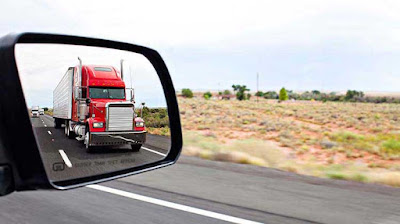In one recent year, just tanker trucks
specifically were involved in 5,733 crashes. Of those, 372 were
deadly. This doesn’t even take into account all the other types of big trucks
on the road.
Trying to avoid big trucks can be
an important part of staying safe on the road, as can defensive driving
techniques.
The following are things to keep
in mind when it comes to safely share the road with big trucks or even
staying away from them as much as you can.
Give Them Space
The most important thing you can do on the roadway is given big trucks, as well as buses and RVs, plenty of space. Give them significantly
more space than you would even another passenger vehicle.
When you give big trucks more space, you’re shielding
yourself from a lot of potential risk of sharing the road with them.
It’s one of the single most effective tactics to protect yourself, along with
remaining vigilant and alert.
You should aim to give regular passenger vehicles a three-second distance at least, so with big vehicles and trucks, go for at
least five.
Also, as a side note, if you can’t see the truck driver’s
face in their mirrors, they can’t see you.
Along with generally leaving
enough space when you’re near a big truck, ensure that you leave
enough room for trucks to change lanes when they need to and never pull over in
front of big trucks. A truck driver doesn’t have the ability to stop quickly,
especially if they’re pulling a heavy load.
Be Cognizant of Cargo
It’s not just the truck itself that can be potentially
dangerous to share the road with when you’re driving. You need to watch out for
the cargo too.
For example, if you’re driving too near a flatbed truck with
oversized cargo and the load falls, it can cause severe injuries to people
nearby in a passenger vehicle.
As far as 18-wheelers with closed trailers, if you see the
trailer doors looking partially open or perhaps moving, then it could mean they
aren’t secured the right way. You should move out of the way.
Give Room for Turns
A lot of accidents
involving big trucks occur when they are trying to turn. Watch out
for a truck’s signals.
If a truck driver is signaling they need to turn right,
don’t pull up to the trucks’ right side. They need the space for a wide turn.
Know Trucks’ Blind Spots
By understanding the blind spots of a truck and the driver,
you’re more prepared to make safe driving decisions.
For example, truck blind spots can include areas on either
side of the truck and the area that’s right in front of it. The area right
behind a truck is also a blind spot.
Don’t spend time in a truck’s blind spots if at all
possible. You might need to slow down or speed up to get out of a blind spot.
Overall, try not to ever drive right next to a truck.
Pass Quickly
If you have to pass a truck, do so as fast as you can. Due
to the blind spots listed above, truck drivers might not be aware of what
you’re doing or even that you’re there in the first place. If you’re going to
pass a truck, ensure you have ample space.
Use Your Turn Signals
Turn signals are something that is so important for all
drivers. If you’re going to be changing lanes or turning, use your signals.
Truck drivers need those signals to know what they should do next.
Be Mindful of Driving
When a truck driver is tired, texting, or even under the
influence of substances, you might notice them drifting between lanes. Trucks
can also drift when the winds are high and the vehicle is pushed around,
especially if the truck isn’t fully loaded.
Watch for indications a truck is drifting, and stay as far
away as you reasonably can.
Overall, following defensive driving
guidelines will be best to avoid getting into an accident with a big
truck. There are certain things you can’t control on the roadway, but you can
fully control your own driving behavior and decisions.
Avoid any sudden lane changes or movements and give notice
if you need to make a change.











